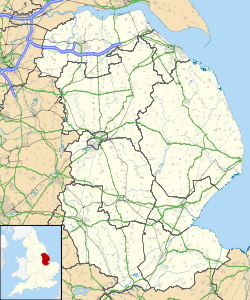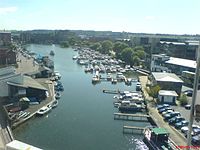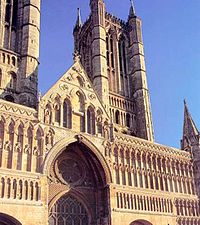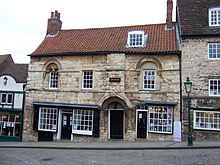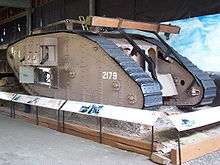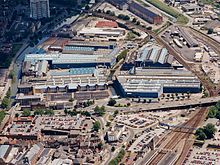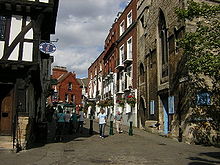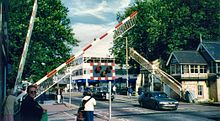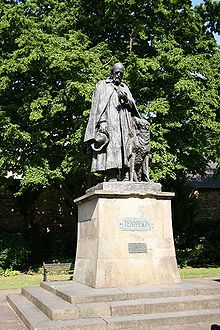- Lincoln, England
-
City of Lincoln — City & Borough — Castle Square, Lincoln Lincoln shown within Lincolnshire Lincoln shown within Lincolnshire Coordinates: 53°13′58″N 0°32′16″W / 53.23272°N 0.537661°W Sovereign state United Kingdom Constituent country England Region East Midlands Non-metropolitan county Lincolnshire Status Non-metropolitan district, Borough, City Admin HQ Lincoln Incorporated 1 April 1974 Government - Type Non-metropolitan district council - Body City of Lincoln Council - Leadership Leader & Cabinet (Labour) - MPs Karl McCartney Area - Total 13.8 sq mi (35.69 km2) Area rank 300th (of 326) Population (2010 est.) - Total 89,700 - Rank 258th (of 326) - Density 6,509.4/sq mi (2,513.3/km2) - Ethnicity 97.8% White Time zone GMT (UTC0) - Summer (DST) BST (UTC+1) Postcodes LN1-LN6 Area code(s) 01522 ONS code 32UD OS grid reference SK9771 Website lincoln.gov.uk Lincoln (
 /ˈlɪŋkən/) is a cathedral city and county town of Lincolnshire, England.
/ˈlɪŋkən/) is a cathedral city and county town of Lincolnshire, England.The non-metropolitan district of Lincoln has a population of 85,595;[1] the 2001 census gave the entire area of Lincoln a population of 120,779.[2]
It has several twin towns: Port Lincoln, South Australia; Radomsko, Poland; Tangshan, China; and Neustadt an der Weinstraße, Germany.
Contents
History
Earliest history: Lincoln
The earliest origins of Lincoln can be traced to the remains of an Iron Age settlement of round wooden dwellings (which were discovered by archaeologists in 1972) that have been dated to the 1st century BC[citation needed] This settlement was built by a deep pool (the modern Brayford Pool) in the River Witham at the foot of a large hill (on which the Normans later built Lincoln Cathedral and Lincoln Castle) .
The origins of the name Lincoln may come from this period, when the settlement is thought to have been named in the Brythonic language of Iron Age Britain's Celtic inhabitants as Lindon "The Pool",[3] presumably referring to the Brayford Pool (compare the etymology of the name Dublin, from the Gaelic "dubh linn" ("black pool")). It is not possible to know how big this original settlement was as its remains are now buried deep beneath the later Roman and medieval ruins, as well as the modern Lincoln.
Roman history: Lindum Colonia
Main article: Lindum ColoniaThe Romans conquered this part of Britain in AD 48 and shortly afterwards built a legionary fortress high on a hill overlooking the natural lake formed by the widening of the River Witham (the modern day Brayford Pool) and at the northern end of the Fosse Way Roman road (A46). The Celtic name Lindon was subsequently Latinized to Lindum and given the title Colonia when it was converted into a settlement for army veterans.[4]
The conversion to a colonia was made when the legion moved on to York (Eboracum) in AD 71. Lindum colonia or more fully, Colonia Domitiana Lindensium, after its founder Domitian, was established within the walls of the hilltop fortress with the addition of an extension of about equal area, down the hillside to the waterside below.
It became a major flourishing settlement, accessible from the sea both through the River Trent and through the River Witham, and was even the provincial capital of Flavia Caesariensis when the province of Britannia Inferior was subdivided in the early 4th century, but then it and its waterways fell into decline. By the close of the 5th century the city was largely deserted, although some occupation continued under a Praefectus Civitatis, for Saint Paulinus visited a man of this office in Lincoln in AD 629.
AD 410–1066
Main article: Lincoln CastleDuring this period the Latin name Lindum Colonia was shortened in Old English to become 'Lincylene'[5].
After the first destructive Viking raids, the city once again rose to some importance, with oversea trading connections. In Viking times Lincoln was a trading centre that issued coins from its own mint, by far the most important in Lincolnshire and by the end of the 10th century, comparable in output to the mint at York.[6] After the establishment of Dane Law in 886, Lincoln became one of The Five Boroughs in the East Midlands. Excavations at Flaxengate reveal that this area, deserted since Roman times, received new timber-framed buildings fronting a new street system, ca 900.[7] Lincoln experienced an unprecedented explosion in its economy with the settlement of the Danes. Like York, the Upper City seems to have been given over to purely administrative functions up to 850 or so, while the Lower City, running down the hill towards the River Witham, may have been largely deserted. By 950, however, the banks of the Witham were newly developed with the Lower City being resettled and the suburb of Wigford quickly emerging as a major trading centre.. In 1068, two years after the Norman conquest, William I ordered Lincoln Castle to be built on the site of the former Roman settlement, for the same strategic reasons and controlling the same road.
Cathedral
Main article: Lincoln CathedralConstruction of the first Lincoln Cathedral, within its close or walled precinct facing the castle, began when the see was removed from Dorchester and completed in 1092; it was rebuilt after a fire but was destroyed by an unusual earthquake in 1185. The rebuilt Lincoln Minster, enlarged to the east at each rebuilding, was on a magnificent scale, its crossing tower crowned by a spire reputed to have been 525 ft (160 m) high, the highest in Europe. When completed the central of the three spires is widely accepted to have succeeded the Great Pyramids of Egypt as the tallest man-made structure in the world.
Main article: Bishop of LincolnThe bishops of Lincoln were among the magnates of medieval England: the diocese of Lincoln, the largest in England, had more monasteries than the rest of England put together, and the diocese was supported by large estates.
When Magna Carta was drawn up in 1215, one of the witnesses was Hugh of Wells, Bishop of Lincoln. One of only four surviving originals of the document is preserved in Lincoln Castle.
Among the most famous bishops of Lincoln were Robert Bloet, the magnificent justiciar to Henry I; Hugh of Avalon, the cathedral builder canonised as St Hugh of Lincoln; Robert Grosseteste, the 13th century intellectual; Henry Beaufort, a politician deeply involved in the Wars of the Roses; Philip Repyngdon, chaplain to Henry IV of England and defender of Wycliffe; Thomas Wolsey.
The administrative centre was the Bishop's Palace, the third element in the central complex. When it was built in the late 12th century, the Bishop's Palace was one of the most important buildings in England. Built by the canonised bishop Hugh of Lincoln, the palace's East Hall range over a vaulted under-croft is the earliest surviving example of a roofed domestic hall. The chapel range and entrance tower were built by Bishop William of Alnwick, who modernised the palace in the 1430s. Both Henry VIII and James I were guests of bishops here; the palace was sacked by royalist troops during the Civil War in 1648.
Following a recent break-in, some of the stained glass windows of the cathedral have had to be replaced.
Medieval town
During the Anarchy, in 1141 Lincoln was the site of a battle between King Stephen and the forces of Empress Matilda, lead by her illegitimate halfbrother Robert, 1st Earl of Gloucester. After fierce fighting in the city's streets, Stephen's forces were defeated. Stephen himself was captured and taken to Bristol.
By 1150, Lincoln was among the wealthiest towns in England. The basis of the economy was cloth and wool, exported to Flanders; Lincoln weavers had set up a guild in 1130 to produce Lincoln Cloth, especially the fine dyed 'scarlet' and 'green', the reputation of which was later enhanced by Robin Hood wearing woollens of Lincoln green. In the Guildhall that surmounts the city gate called the Stonebow, the ancient Council Chamber contains Lincoln's civic insignia, probably the finest collection of civic regalia.
Outside the precincts of cathedral and castle, the old quarter clustered around the Bailgate, and down Steep Hill to the High Bridge, which bears half-timbered housing, with the upper storeys jutting out over the river. There are three ancient churches: St Mary le Wigford and St Peter at Gowts are both 11th century in origin and St Mary Magdalene, built in the late 13th century, is an unusual English dedication to the saint whose cult was coming greatly into vogue on the European continent at that time.
Lincoln was home to one of the five most important Jewish communities in England, well established before it was officially noted in 1154. In 1190, anti-semitic riots that started in King's Lynn, Norfolk, spread to Lincoln; the Jewish community took refuge with royal officials, but their habitations were plundered. The so-called 'House of Aaron' has a two-storey street frontage that is essentially 12th century and a nearby Jew's House likewise bears witness to the Jewish population. In 1255, the affair called 'The Libel of Lincoln' in which prominent Jews of Lincoln, accused of the ritual murder of a Christian boy ('Little Saint Hugh of Lincoln' in medieval folklore) were sent to the Tower of London and 18 were executed. The Jews were expelled en masse in 1290.
During the 13th century, Lincoln was the third largest city in England and was a favourite of more than one king. During the First Barons' War, it became caught up in the strife between the king and the rebel barons, who had allied with the French. It was here and at Dover that the French and Rebel army was defeated. In the aftermath of the battle, the town was pillaged for having sided with Prince Louis.
However, during the 14th century, the city's fortunes began to decline. The lower city was prone to flooding, becoming increasingly isolated, and plagues were common. In 1409, the city was made a county corporate.
16th century
The Dissolution of the Monasteries further exacerbated Lincoln's problems, cutting off the main source of diocesan income and drying up the network of patronage controlled by the bishop, with no less than seven monasteries within the city alone closed down. This was accompanied by closure of a number of nearby parliamentary abbeys which led to a further diminishment of the region's political power. When the cathedral's great spire rotted and collapsed in 1549 and was not replaced, it was a significant symbol of Lincoln's economic and political decline. However, the comparative poverty of post-medieval Lincoln preserved pre-medieval structures that would probably have been lost in more prosperous contexts.
Civil War
 The west front of Lincoln Cathedral viewed through the Exchequer Gate, one of a number of surviving gates in the Cathedral Close walls.
The west front of Lincoln Cathedral viewed through the Exchequer Gate, one of a number of surviving gates in the Cathedral Close walls.
Between 1642 and 1651, during the English Civil War, Lincoln was on the frontier between the Royalist and Parliamentary forces and therefore changed hands several times. Many buildings were badly damaged. Lincoln now had no major industry, no easy access to the sea and was poorly placed. As a consequence of this, while the rest of the country was beginning to prosper in the beginning of the 18th century, Lincoln suffered immensely, travellers often commenting on the state of what had essentially become a 'one street' town.
Georgian Age
By the Georgian era, Lincoln's fortunes began to pick up, thanks in part to the Agricultural Revolution. The re-opening of the Foss Dyke canal allowed coal and other raw materials vital to industry to be more easily brought into the city.
As well as the economic growth of Lincoln during this era, the city boundaries expanded to include the West Common. To this day, an annual 'Beat the Boundaries' walk takes place along the perimeter of the common.
Industrial Revolution
Coupled with the arrival of the railway links, Lincoln boomed again during the Industrial Revolution, and several world-famous companies arose, such as Ruston's, Clayton's, Proctor's and William Foster's. Lincoln began to excel in heavy engineering, building diesel engine locomotives, steam shovels and all manner of heavy machinery.
20th century
Lincoln was hit by a major typhoid epidemic between November 1904 and August 1905 caused by polluted drinking water from Hartsholme Lake and the River Witham. Over 1,000 people contracted the disease and fatalities totalled 113, including the very man responsible for the city's water supply, Matthew Robinson of Baker Crescent. Westgate Water Tower was constructed to provide new water supplies to the city.
In the world wars, Lincoln switched to war production. The first ever tanks were invented, designed and built in Lincoln by William Foster & Co. during the First World War and population growth provided more workers for even greater expansion. The tanks were tested on land now covered by Tritton Road (in the south-west suburbs of the city). During the Second World War, Lincoln produced a vast array of war goods, from tanks, aircraft, munitions and military vehicles.
Ruston and Hornsby produced diesel engines for ships and locomotives, then by teaming up with former colleagues of Frank Whittle and Power Jets Ltd, in the early 1950s, R & H (which became RGT) opened the first ever production line to build gas turbine engines for land-based and sea-based energy production. Hugely successful, it was largest single employer in the city, providing over 5,000 jobs in its factory and research facilities, making it a rich takeover target for industrial conglomerates. It was taken over by GEC in the late 1960s with diesel engine production being transferred to the Ruston Diesels Division in Newton-le-Willows, Lancashire of GEC at the former Vulcan Foundry, which was eventually bought by the German MAN B&W Diesel in June 2000.
It merged with Alstom of France in the late 1980s, then in 2003 was bought out by Siemens AG of Germany, now being called Siemens Industrial Turbomachinery. This also includes what is left of Napier Turbochargers. Plans were announced early in 2008 for the construction of a new plant just outside the city boundary at Teal Park, North Hykeham.[8] Unfortunately Siemens made large scale redundancies and moved jobs to both Sweden and the Netherlands. The factory now employs 1300 people and Siemens have shelved plans to build a new factory promised to its employees.
Lincolns second largest private employer is James Dawson and Son a belting and Hose Manufacturer founded in Lincoln in the late 19th century. Located on the city's Tritton road next to the university it still operates using a coal fired boiler. Dawsons became part of the Hull based Fenner group in the late 1970s.
In the post-war years after 1945, new suburbs were built, but heavy industry declined towards the end of the 20th century, mimicking the wider economic profile of the United Kingdom. More people are nevertheless still employed today in Lincoln building gas turbines than anything else.Economy
Lincoln's economy is based mainly on public administration, commerce, arable farming and tourism, with industrial relics like Rustons (now Siemens) still in existence. However, many of Lincoln's industrial giants have long ceased production in the city, leaving large empty industrial warehouse-like buildings. More recently, these buildings have become multi-occupant units, with the likes of Lincs FM radio station (in the Titanic Works) and LA Fitness gym taking up space.
Like many other cities in Britain, Lincoln has developed a growing IT economy, with many e-commerce mail order companies setting up in or around the city. A plethora of other, more conventional small industrial businesses are located in and around Lincoln. One of the reasons for building the university was to increase inward investment and act as a springboard for small companies. The university's presence has also drawn many more licensed premises to the town centre around the Brayford Pool. A new small business unit next door to a university accommodation building, the Think Tank, opened in June 2009.[9]
The Extra motorway services company is based on Castle Hill, with most new UK service areas being built by Swayfields who are the parent company. There are two main electronics companies in the town: Chelmsford-based e2V (formerly Associated Electrical Industries before 1961) is situated between Carholme Road (A57) and the Foss Dyke next-door to Carholme Golf Club;[10] and Dynex Semiconductor (formerly Marconi Electronic Devices) is on Doddington Road (B1190) near the A46 bypass just inside the borough boundary, and near North Hykeham.
Retail parks
Around the Tritton Road (B1003) trading estate, many new businesses have begun trading from large units with car parking. Lincoln has a choice of five large national supermarkets. The recently developed St Mark's Square complex has Debenhams as the flagship store and has an accompanying trading estate with well known chain stores such as BHS.
Another development is also expected to be completed by 2011-12 called Lindongate which includes plans for a new department store, shops, hotel, flats and new transport facilities. The viability of proposed developments such as this may, however, now be called into question by the sudden economic downturn starting late in 2007. The scheme depends on a continuing demand for retail space, and a continuation of a strong housing market, but by mid-2008 both of these factors had become conspicuously absent.
Tourism
The city is a tourist centre and those who come do so to visit the numerous historic buildings including the cathedral, the castle, and the Medieval Bishop's Palace.
The Collection, of which the Usher Gallery is now a part, is an important attraction. Housed partly in a recently opened, purpose-built venue, it currently contains over 2,000,000 objects, and was one of the four finalists for the 2006 Gulbenkian Prize. Any material from official archaeological excavations in Lincolnshire is eventually deposited at in The Collection so it is growing all the time.
 Waterside Empowerment 2002 sculpture
Waterside Empowerment 2002 sculpture
Other attractions include the Museum of Lincolnshire Life and the Sir Joseph Banks Conservatory at the Lawn, adjacent to Lincoln Castle. Tranquil destinations close by include Whisby Nature Reserve and Hartsholme Country Park (including the Swanholme Lakes Local Nature Reserve), while noisier entertainment can be found at Waddington airfield, Scampton airfield (base of the RAF's Red Arrows jet aerobatic team), the County Showground or the Cadwell Park motor racing circuit near Louth.
Because of its climate, Lincoln attracts many of its tourists in summer, but also on the first Thursday of December until the following Sunday when the Bailgate area of the city holds its annual Christmas Market in and around the Castle grounds. The market is based upon the traditional German-style Christmas market as found in several German cities, including Lincoln's 'twin town' Neustadt an der Weinstrasse. In 2010, for the first time in the history of the Christmas Market, the event was cancelled due to 'atrocious conditions' of heavy snowfall across Lincolnshire and most of the United Kingdom.[11][12]
Topography: 'uphill' and 'downhill'
Lincoln is built at the point where there is a gap in the Lincoln Cliff (a limestone escarpment running north-south and rising to 200 feet (60 m) in height, also sometimes called the 'Lincoln(shire) Edge' or 'Lincoln Heath'). The River Witham flows through this gap. Lincoln is thus divided informally into two zones, known locally as uphill and downhill.
The uphill area comprises the northern part of the city, on top of the Lincoln Cliff (to the north of the gap). This area includes the historical quarter, including the cathedral, Lincoln Castle and the Medieval Bishop's Palace, known locally as the Bail (although described in tourist promotional literature as 'the Cathedral Quarter'). It also includes residential suburbs to the north and northeast. The downhill area comprises the city centre (located in the gap) and the suburbs to the south and south-west. The aptly named street Steep Hill connects the two (although it is too steep for vehicular traffic, which must take a more circuitous route).
This divide marks out Lincoln from other historic cities in England and elsewhere in Europe. Whereas in most such cities, the chief historical buildings (cathedrals and castles) tend to be centrally located and intermingled with the present-day city centre, in Lincoln they are separate.
The divide was also once an important class distinction, with 'uphill' more affluent and 'downhill' less so. This distinction dates from the time of the Norman conquest, when the religious and military elite occupied the hilltop. The construction and expansion of suburbs in both parts of the city since the mid-19th century has diluted this distinction, nevertheless 'uphill' residential property continues to fetch a premium, and is almost invariably referred to as such in literature emanating from local estate agents. Membership of noted uphill organisations such as the Lincoln Astronomical Society, the Lincoln Backgammon Club, the Lincoln Uphill Gardeners' Club and the Lincoln Waits is seen as a mark of local success, and much prized.
In the UK government scale of economic deprivation for district councils which varies 1 to 5, Lincoln and Boston have been graded as 4. However, this is an average figure, with 'uphill' Lincoln being more likely to be around 2.
Climate
As with the rest of the British Isles, Lincoln experiences a maritime climate with cool summers and mild winters. The nearest Met Office weather station is Waddington, about 4 miles to the south of the city centre. Temperature extremes since 1948 have ranged from as high as 34.8 °C (94.6 °F) in August 1990,[13] to as low as −15.6 °C (3.9 °F) in February 1956.[14] A now closed weather station still holds the record for lowest daytime maximum temperature recorded in England in the month of December; −9 °C (15.8 °F) on the 17th December 1981.[15] The coldest temperature reported in recent years was −10.4 °C (13.3 °F) during December 2010,[16] although another weather station, at Scampton, a similar distance north of the city centre fell to −15.6 °C (3.9 °F), thus equalling the Waddington's record low set in 1956.[17]
Climate data for Waddington 68m asl, 1971-2000, extremes 1948- (Weather station 4 miles (6 km) to the South of Lincoln) Month Jan Feb Mar Apr May Jun Jul Aug Sep Oct Nov Dec Year Record high °C (°F) 13.9
(57.0)17.4
(63.3)22.4
(72.3)26.1
(79.0)27.8
(82.0)32.4
(90.3)32.2
(90.0)34.8
(94.6)30.0
(86.0)29.2
(84.6)17.8
(64.0)15.1
(59.2)34.8
(94.6)Average high °C (°F) 6.3
(43.3)6.7
(44.1)9.4
(48.9)11.7
(53.1)15.4
(59.7)18.3
(64.9)21.0
(69.8)20.9
(69.6)17.7
(63.9)13.6
(56.5)9.2
(48.6)7.0
(44.6)13.1 Average low °C (°F) 1.0
(33.8)1.0
(33.8)2.5
(36.5)4.0
(39.2)6.7
(44.1)9.7
(49.5)11.9
(53.4)11.8
(53.2)9.8
(49.6)6.8
(44.2)3.6
(38.5)2.0
(35.6)5.9 Record low °C (°F) −13.8
(7.2)−15.6
(3.9)−11.1
(12.0)−4.7
(23.5)−2
(28.4)0.0
(32.0)3.3
(37.9)3.9
(39.0)0.0
(32.0)−3.2
(26.2)−6.7
(19.9)−14
(7)−15.6
(3.9)Precipitation mm (inches) 52.4
(2.063)37.8
(1.488)47.4
(1.866)44.4
(1.748)47.7
(1.878)55.3
(2.177)44.5
(1.752)57.6
(2.268)51.1
(2.012)53.4
(2.102)52.1
(2.051)55.1
(2.169)598.7
(23.571)Sunshine hours 58.6 73.2 109.7 143.7 201.8 185.7 200.0 191.7 140.7 109.4 70.8 52.4 1,537.9 Source no. 1: Met Office[18] Source no. 2: Royal Dutch Meteorological Institute/KNMI[19] Transport
Railway
Main article: Lincoln Central railway stationThe station has five platforms and has a steady flow of trains and passengers passing through. Trains run to a range of destinations including Newark-on-Trent, Grimsby and Peterborough. Unfortunately the electrification of the East Coast Mainline (ECML) in the late 1980s saw the demise of direct services from Lincoln into London, forcing a change at Newark or Peterborough for services via the ECML to London or changing for services via the Midland Main Line (MML) to London St Pancras.
From May 2010, East Coast began a new direct train service to London, calling at Newark, Peterborough and Stevenage. One service in each direction operates weekly, although only a journey north from London happens on Sundays.[20]
Level crossings
Electrification of the East Coast Main Line prompted an increase in traffic that has led to many of the goods trains running between Doncaster and Peterborough being diverted through Lincoln. This coupled with goods traffic between the Midlands and the ports and oil refineries in the Grimsby, Immingham and Killingholme area and local passenger services operating in and out of Lincoln Central railway station, has led to High Street level crossing (which cuts the central shopping area in two) being closed for up to 22 minutes out of every hour.[21] Improvements in the station area in 2008 may have sped up the goods traffic through Lincoln.[22]
The city's MP and the Chamber of Commerce have suggested that this[vague] may be deterring inward investment by new employers.[23] This has been an issue in Lincoln since the 1860s according to Hansard records.
Up until 1986 a second level crossing crossed on High Street outside the (now closed) Lincoln St. Mark's railway station.
Roads
The £19-million A46 bypass was opened in December 1985. Its route (to the A158) was originally proposed in October 1975 at a cost of £13.5 million. The bypass is currently exceeding its designed capacity from the North Hykeham roundabout (A1434) to the B1378 Skellingthorpe Road roundabout, especially in the summer on weekends.[says who?] The section from the end of the dual-carriageway at the B1241 (former B1378) roundabout to the B1190 roundabout is currently being upgraded to dual-carriageway. The B1190 is an east-west road through Lincoln, starting from the Nottinghamshire-Lincolnshire boundary on the (Roman) Foss Dyke and A57 and finishing in the east at Thimbleby on the A158 near Horncastle. It originally terminated at the Canwick Road junction, then was extended to the west.[citation needed]
For many years[when?] the two main roads through Lincoln were the A46 and A15; there were no other main roads, and they both passed along the High Street. At the intersection of Guildhall Street and the High Street, these two roads met the A57, where it terminated. North of the city centre, the former route of the A15, Riseholme Road is the B1226, and that of the A46, Nettleham Road, is the B1182. The early northern inner ring-road, formed of Yarborough Road and Yarborough Crescent was originally the B1193, then an A road for many years, the A1102, from the mid-1930s and after the bypass was built, this distributor road became the B1273.
The western distributor road Tritton Road, named after the designer of the tank Sir William Tritton,[citation needed] was built as the A1180. When the bypass was built in 1986 Tritton Road became the B1003. For many years after Tritton Road was built it terminated at Ropewalk, with volumes of traffic leading to either Brayford Wharf or St Mark Street and the High Street. When the University was built, the area needed to be accessed[says who?] from the west leading to Brayford Way being built over the Foss Dyke. This has eased Lincoln's transport infrastructure[says who?] because the High Street and Brayford Wharf both have level crossings over the railway, whereas Brayford Way has a much-needed[says who?] bridge. Brayford Way was originally part of the plans for Tritton Road well before the University was built, but the bridge over the railway to Carholme Road (A57) was strongly opposed by residents[says who?] on Yarborough Crescent who did not wish it to become a rat run.[citation needed]
For many decades Lincoln was barely connected to the UK trunk road network until the A46 to Newark was remodelled as the dual carriageway Newark to Lincoln Improvement in July 2003 at a cost of £28 million, which has made the city more accessible,[citation needed] built by Alfred McAlpine, with the contract awarded on 2 November 2001.[citation needed] Lincoln has its own bypass problems,[says who?] however, funding for the A15 eastern bypass was reviewed in 2006 by the East Midlands Regional Assembly, the bypass being postponed for several years with it unlikely to be built before 2016.[says who?]
Education
Higher education
Lincoln has two higher education institutions, the older being Bishop Grosseteste University College, which started life as a teacher training college linked to the Anglican Church in 1862. During the 1990s, the college branched out into new subject areas with a focus on the arts and drama. Bishop Grosseteste College as it was became a University College in 2006 when it was awarded taught degree powers, meaning that students graduate with degrees from BGUC and not the University of Leicester as previously. A graduation celebration takes place every year in Lincoln Cathedral. Bishop Grosseteste University College has no links with the University of Lincoln.[citation needed]
 Riseholme Hall, Universty of Lincoln Further Education Department
Riseholme Hall, Universty of Lincoln Further Education Department
The larger University of Lincoln started life as the University of Lincolnshire and Humberside in 1996, when the University of Humberside opened a Lincoln campus next to Brayford Pool, attracting additional students to the city. Lincoln Art College (which was Lincolnshire's main outlet for higher education) and Riseholme Agricultural College, which had previously been part of De Montfort University in Leicester, were absorbed into the University in 2001, and subsequently the Lincoln campus took priority over the Hull campus.[citation needed]
Most buildings were built after 2001.[citation needed] The university changed its name to the University of Lincoln in September 2002. In the 2005/6 academic year, 8,292 full time undergraduates were studying at the university.[24] Around 2002 there was considerable local annoyance with students' residences in the West End area. This subsided with vast numbers of student flats being built next to the Foss Dyke and Brayford Way B1273 bridge. Student life has resulted in the building of the Engine Shed theatre complex on Brayford Wharf East.[citation needed]
Further education
Further education courses in Lincoln are provided by Lincoln College, which is the largest education institution in Lincolnshire, with 18,500 students, of whom 2,300 are full time.[25] Also, Lincoln has an Access To Music branch, situated above Pulse and Ritzy, on Flaxengate.[citation needed]
Schools
 Former Lincoln Christ's Hospital Girls' High School, now houses the University of Lincoln's school of Fine Art
Former Lincoln Christ's Hospital Girls' High School, now houses the University of Lincoln's school of Fine Art
The school system in Lincoln is anomalous within Lincolnshire despite being part of the same local education authority, as most of Lincolnshire retained the grammar school system. Other areas near Lincoln, such as North Hykeham, Branston and Cherry Willingham, also have comprehensive schools.[citation needed]
In 1952, William Farr School was founded in Welton, a nearby village. Lincoln itself had four single-sex grammar schools until September 1974. In 1994 Lincolnshire County Council proposed to convert the City School on Skellingthorpe Road into a grammar school, but opinions expressed by some parents caused a reversal of policy.[citation needed]
Since 1992 The Priory Academy LSST, created an Academy in 2008 and using selection tests for entrance, receives A level results better than five[which?] Lincolnshire grammar schools.[citation needed]
In 2008 the Priory Federation of Academies was formed when The Priory Academy LSST absorbed Joseph Ruston School (formerly Ancaster High School) and Usher Junior School and was renamed The Priory Witham Academy, and The Priory City of Lincoln Academy.[clarification needed][citation needed]
Lincoln as a district historically came the lowest in the county for average GCSE results, although has improved in recent years.[citation needed] South Kesteven and West Lindsey get the best results.[clarification needed][citation needed]
Media
The local newspaper is the Lincolnshire Echo, which was founded in 1894. Local radio stations are BBC Lincolnshire on 94.9FM, its commercial rival Lincs FM on 102.2FM and Lincoln City Radio on 103.6FM a community radio station catering primarliy for people aged over 50 years.[26] The Lincolnite is the online and mobile publication covering the greater Lincoln area.[27] Local listeners can also tune into Siren FM, which broadcasts on 107.3FM from the University of Lincoln
Student publications The Linc[28] and Bullet[29] are available both online and in print, and target the University Of Lincoln's growing student population.
BBC Look North have a bureau in Lincoln as an integral part of their coverage of Lincolnshire and East Yorkshire. There are three TV reporters based in Lincoln serving both BBC Look North and East Midlands Today.
Other local media outlets include Bailgate Independent,[30] Love Lincoln[31] and Lincolnista.[32]
Sport
Lincoln has a professional football team, Lincoln City F.C., nicknamed 'The Imps', which plays at the Sincil Bank stadium on the southern edge of the city. The collapse of ITV Digital, which owed Lincoln City FC more than £100,000, in 2002 saw the team faced with bankruptcy but it was saved after a massive fund-raising venture by the fans that returned ownership of the club to them where it has remained since. The club was famously the first team to be relegated from the English Football League, when automatic relegation to the Football Conference was introduced from the 1986–87 season. Lincoln City regained its league place at the first attempt and has held onto it until the 2010–11 season when they were once again relegated to the Football Conference. Their most successful era was arguably in the early 1980s; they won promotion from the Fourth Division in 1981 and narrowly missed out on promotion to the Second Division in the two years that followed.[1]
Lincoln City were notably the first club managed by Graham Taylor, who managed the English national football team from 1990 to 1993. He was at Lincoln City from 1972 to 1977, during which time the club won promotion from the Fourth Division as champions in 1976 – The club also won the Football League Division Three North title on three separate occasions, a joint record.
Lincoln Ladies F.C. ('The Lady Imps'), as members of the FA WSL, are one of the top eight[33] women's football clubs in England.
Lincoln is also home to Lincoln United F.C, Lincoln Moorlands Railway F.C. and Lincoln Griffins Ladies F.C..
Lincoln also hosts upcoming sports team the Lincolnshire Bombers Roller Girls. A fast upcoming female Roller Derby team, competing across the country and in Europe. The bombers are a self funded non for profit team helping pave the way for UK Roller Derby across the country.
Notable citizens
- Kelly Adams – television and film actress, was born in Lincoln in 1979
- George Boole – mathematician and developer of Boolean logic, born in Lincoln in 1815
- Jim Broadbent – Oscar-winning actor who was born in Wickenby in 1949
- Mark Byford – BBC Deputy Director-General, went to Lincoln School
- William Byrd – A famous Renaissance composer and organist who resided near the Cathedral.
- Lee Chapman – former footballer who scored more than 200 first-team goals as a striker, was born in Lincoln
- Daniel Cox – British juniors tennis player was born in the city in 1990
- Peter Day – BBC broadcaster went to Lincoln School
- Jane Eaglen – opera singer was born in the city in 1962
- James Fenton – poet, journalist and literary critic, born in the city in 1949
- Sheila Gish – RADA actress, including roles in Highlander
- Darrell Hair – former international cricket umpire who recently was stood down after a ball tampering dispute with the Pakistan cricket team. He lives just outside the city, in Nettleham
- Marion Rose Halpenny – equestrian writer and horsewoman known for her pioneering book British Racing and Racecourses, was born in Lincoln
- Alex Henshaw – Spitfire chief test pilot, went to Lincoln School
- John Hurt – actor, went to Lincoln School
- Jonathan Kerrigan - television, film and stage actor, is from Lincoln
- John de Lacy 1192 – July 22, 1240, son of Roger, became Earl of Lincoln
- Sir Neville Marriner - conductor who arranged and conducted the music for the film Amadeus, was born in Lincoln. He attended Lincoln School from 1935-42
- Paul Palmer – swimmer, born in Lincoln, who won the silver medal in the 400 metres Freestyle at the 1996 Olympics in Atlanta, Georgia, USA (also a former pupil of Lincoln Christ's Hospital School)
- Allison Pearson – newspaper columnist, went to Lincoln Christ's Hospital School
- Steve Race – radio broadcaster and host of Radio 4 programme My Music from 1967–93, was born in Lincoln. He attended Lincoln School from 1932-39
- Alfred Tennyson – Poet Laureate of the United Kingdom after William Wordsworth and one of the most popular English poets, was born in Somersby
Twin towns
 Port Lincoln, Australia
Port Lincoln, Australia Tangshan, China
Tangshan, China Neustadt an der Weinstraße, Rhineland-Palatinate, Germany
Neustadt an der Weinstraße, Rhineland-Palatinate, Germany Radomsko, Poland
Radomsko, Poland
See also
Attractions
Places
- Lincoln Performing Arts Centre
- Lincoln Racecourse
- St. Catherines, Lincoln
- Steep Hill
- University of Lincoln
- Bishop Grosseteste University College
People
References
- ^ Office for National Statistics : Census 2001 : Key Statistics : City of Lincoln Retrieved 2009-11-22
- ^ KS01 Usual resident population: Census 2001, Key Statistics for urban areas
- ^ "Matasovic, An Etymological Lexicon of Proto-Celtic". http://www.indo-european.nl/cgi-bin/startq.cgi?flags=endnnnl&root=leiden&basename=%5Cdata%5Cie%5Cceltic.
- ^ Harper, Douglas (© 2001-2011). "Lincoln" (in English). Online Etymology Dictionary. Lancaster, Pennsylvania, USA. http://www.etymonline.com/index.php?term=Lincoln&allowed_in_frame=0. Retrieved 30 October 2011. "Lincoln: English city, county town of Lincolnshire, O.E. Lindcylene, from L. Lindum Colonia from a Latinized form of British *lindo "pool, lake" (corresponding to Welsh llyn). Originally a station for retired IX Legion veterans."
- ^ "Anglo-Saxon Chronicle - Parker MS: entry for 942". http://www8.georgetown.edu/departments/medieval/labyrinth/library/oe/texts/asc/a.html.
- ^ Finds suggest a 100-to-1 preponderance over nominal mints Caistor, Horncastle and Louth; a hoard recovered at Corringham, near Gainsborough, is composed mainly of coins minted at Lincoln and York (David Michael Metcalf, An Atlas of Anglo-Saxon and Norman Coin Finds, c.973-1086, 1998:198-200).
- ^ Richard Hall, Viking Age Archaeology (series Shire Archaeology) 2010:23.
- ^ Siemens Press Release 5 February 2008
- ^ Think Tank
- ^ Carholme Golf Club
- ^ "Christmas Market cancelled". Lincoln, United Kingdom. 2 December 2010. http://www.lincoln.gov.uk/news_det.asp?art_id=14742&sec_id=3478. Retrieved 2 December 2010. "Taking advice from partners, including Lincolnshire Police, East Midlands Ambulance Service and Lincolnshire County Council Highways, organisers at Lincoln Council have taken the decision to cancel the event.
Rob Bradley from the City Council is in charge of safety at the event. He said: 'It is with extreme regret that we have taken the decision to cancel the Lincoln Christmas Market this year. It has taken extreme weather conditions to do this, the first time it’s happened in the history of the market.'" - ^ "Traders say decision to cancel Christmas market is 'a disgrace' and 'a disaster'". Lincolnshire Echo (Lincoln, United Kingdom: Northcliffe Media). 2 December 2010. http://www.thisislincolnshire.co.uk/news/DISASTER/article-2961375-detail/article.html. Retrieved 2 December 2010. "Lincoln Christmas Market has been cancelled for the first time in its 28-year history."
- ^ "1990 temperature". KNMI. http://eca.knmi.nl/utils/monitordetail.php?seasonid=14&year=1990&indexid=TXx&stationid=351.
- ^ "1956 temperature". KNMI. http://eca.knmi.nl/utils/monitordetail.php?seasonid=8&year=1956&indexid=TNn&stationid=351.
- ^ [hhttp://www.metoffice.gov.uk/climate/uk/extremes/monthly_temperature_country.html "1981 temperature"]. UKMO. hhttp://www.metoffice.gov.uk/climate/uk/extremes/monthly_temperature_country.html.
- ^ "2010 temperature". KNMI. http://eca.knmi.nl/utils/monitordetail.php?seasonid=18&year=2010&indexid=TNn&stationid=351.
- ^ "2010 Scampton temperature". KNMI. http://www.tutiempo.net/en/Climate/SCAMPTON_RAF/07-12-2010/33730.htm.
- ^ "Waddington 1971-2000 averages". Met Office. http://www.metoffice.gov.uk/climate/uk/averages/19712000/sites/waddington.html. Retrieved 09 Nov 2011.
- ^ "Waddington extremes". KNMI. http://eca.knmi.nl/utils/mapserver/anomaly.php?indexcat=**&indexid=TXx&year=1977&seasonid=18&create_image=true&minx=-1111428.5714287&miny=-4687142.8571429&maxx=621904.76190476&maxy=-3387142.8571428&MapSize=560%2C420&imagewidth=560&imageheight=420&mainmap.x=344&mainmap.y=283&CMD=QUERY_POINT&CMD=QUERY_POINT#bottom. Retrieved 09 Nov 2011.
- ^ http://www.thisislincolnshire.co.uk/Lincoln-London-train-service-launched-1-000-tickets-costing-just-163-1/story-11207588-detail/story.html
- ^ Railway barriers misery survey revealed 19 February 2009
- ^ Network Rail
- ^ House of Commons Hansard Debates for 22 Feb 2000 (pt 2)
- ^ "Key facts about the University of Lincoln", Lincoln.ac.uk. Retrieved 16 November 2011
- ^ "The College", Web.archive.org. Retrieved 16 November 2011
- ^ "Lincoln City Radio ready to launch". Lincolnshire Echo (Lincoln, United Kingdom: Northcliffe Media). 6 April 2010. http://www.thisislincolnshire.co.uk/news/Lincoln-City-Radio-ready-launch/article-1973377-detail/article.html. Retrieved 6 December 2010. "New sounds will be hitting the airwaves as Lincoln City Radio prepares to launch after nearly 25 years of planning. The community radio station will be blasting out old-school classics from the 50s to the 90s on 103.6 FM."
- ^ The Lincolnite
- ^ The Linc
- ^ Bullet
- ^ Bailgate Independent
- ^ Love Lincoln
- ^ Lincolnista
- ^ "The OOH Lincoln Ladies". LincsMag.com. http://www.lincsmag.com/Lincolnshire_Sport/007_OOH_Lincoln_Ladies_History.html. Retrieved 2010-04-08.
Further reading
- Francis Hill, 1948. Medieval Lincoln (Cambridge: University Press)
External links
Video links
- Pathe Newsreel, 1950, Europes largest foundry opens in Lincoln
- Pathe newsreel, 1934, about Lincoln
- Pathe newsreel, 1933, Lincolnshire regiment parade
- Pathe newsreel, 1933, Lincoln Handicap, racing in Lincoln
Derbyshire Amber Valley • Bolsover • Chesterfield • Derby • Derbyshire Dales • Erewash • High Peak • North East Derbyshire • South Derbyshire

Leicestershire Lincolnshire Boston • East Lindsey • Lincoln • North Kesteven • South Holland • South Kesteven • West Lindsey
Nottinghamshire Ashfield • Bassetlaw • Broxtowe • Gedling • Mansfield • Newark and Sherwood • Nottingham • Rushcliffe
Northamptonshire Rutland Cities of the United Kingdom England Bath · Birmingham · Bradford · Brighton and Hove · Bristol · Cambridge · Canterbury · Carlisle · Chester · Chichester · Coventry · Derby · Durham · Ely · Exeter · Gloucester · Hereford · Kingston upon Hull · Lancaster · Leeds · Leicester · Lichfield · Lincoln · Liverpool · London · Manchester · Newcastle upon Tyne · Norwich · Nottingham · Oxford · Peterborough · Plymouth · Portsmouth · Preston · Ripon · St Albans · Salford · Salisbury · Sheffield · Southampton · Stoke-on-Trent · Sunderland · Truro · Wakefield · Wells · Westminster · Winchester · Wolverhampton · Worcester · York
Scotland Wales Northern Ireland Ceremonial county of Lincolnshire Unitary authorities Boroughs or districts Major settlements Alford • Barton-upon-Humber • Boston • Bourne • Brigg • Broughton • Burgh-le-Marsh • Caistor • Cleethorpes • Crowland • Crowle • Epworth • Gainsborough • Grantham • Grimsby • Holbeach • Horncastle • Immingham • Kirton-in-Lindsey • Lincoln • Long Sutton • Louth • Mablethorpe • Market Deeping • Market Rasen • North Hykeham • Scunthorpe • Skegness • Sleaford • Spalding • Spilsby • Stamford • Wainfleet All Saints • Winterton • Wragby
See also: List of civil parishes in LincolnshireTopics Categories:- Lincoln, England
- Populated places established in the 1st century BC
- Local government in Lincolnshire
- County towns in England
- Roman colonies
- Cities in the East Midlands
- Non-metropolitan districts of Lincolnshire
- Local government districts of the East Midlands
Wikimedia Foundation. 2010.



